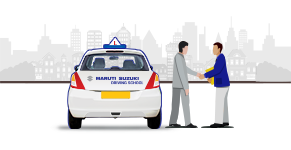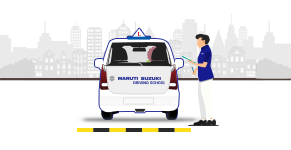Access blogs, quizzes, and the latest driving updates at your fingertips!

When it comes to driving, a driving license is one of the most important identification documents in India. It is extremely important to have a license before you drive a car since it works as your permit to drive on Indian roads. Most people already know what a driving license in India is, but how much do you actually know about it? Let’s detail it out.
A Driving license is a document that is issued by the Indian government which permits people to drive different types of vehicles on the road. In India, the license is issued by the Regional Transport Office or the Regional Transport Authority (RTO / RTA) of each state. The license is most commonly referred to as a DL. It helps in confirming that the driver has:
The DL consists of a registration number and a passport-sized photograph of the license owner for the purpose of identification. Along with this, the driving license has a rubber stamp, the signature of the RTO officer-in-charge, and the address of the office that issued the DL.
Driving licenses are of different types, which are issued based on the type of vehicle that you want to drive. Following are the main types of licenses that you should be aware of: –
If you are learning how to drive a vehicle in India, it is mandatory to have a learner’s license. This acts as a provisional license that allows you to practice driving on the road. However, a person having a permanent DL must be accompanying you. To acquire a learner’s license, the applicant must have good knowledge of road rules and should have passed a written or online test.
Once you finish learning how to drive and pass the driving test, you will receive a permanent driver’s license, 30 days after receiving the learner’s license. There is a particular time period for which this license is valid, after which you have to apply for the renewal of your driver license.
If you wish to drive in foreign countries, you need to have an international driving permit (IDP) which acts as an official travel document and is certified by the United Nations (UN). The IDP is given to tourists who are travelling to foreign countries; for an Indian citizen travelling abroad, the IDP must be applied for in India.
The light motor vehicle license allows you to drive vehicles such as autos, taxis, delivery vans, jeeps, and so on. On the other hand, a heavy motor vehicle license is for those driving buses, cranes, trucks, and similar vehicles. Both these licenses are commercial licenses that permit an individual to drive a commercial vehicle as authorised by the RTO of the state. Applicants need to get their learner's license before they apply for a light or heavy motor vehicle license.
To get a driving license in India, the eligibility depends on the type of vehicle that you want to drive.
1. For a motorcycle without gears, up to 50cc, the applicant must be at least 16 years of age and the consent of a parent or guardian is needed if the applicant is below 18.
2. To acquire a license for motorcycles with gears, the applicant must be 18 years old.
3. For commercial heavy and transport vehicles, the applicant should have completed their education up to 8th standard at least and must be more than 18 years old. In some states, the age requirement is 20 years.
While applying for a driving license, you need to submit a number of documents like your birth certificate, PAN card, passport, 10th class mark sheet, transfer certificate from any school for any class with your date of birth printed on it, AADHAR card, and so on. Know About These Documents in Detail
Point to Note: A general requirement for acquiring a driving license is that the applicant must be well-versed with the traffic rules and regulations and should have valid address and age proofs. Also, keep a track of the license's expiry date as it will help you get your driver license renewal process started on time so that there is no gap in its validity. At Maruti Suzuki Driving School, we provide world-class training to help you become a confident and responsible driver and offer license assistance as well. Come, get to know us. better.
Until recently, a commercial driving licence was mandatory for all those wanting to drive any type of commercial vehicle. In fact, in order to obtain a commercial driving licence, an individual needed to wait for a year after holding a private driving licence. However, in April 2018, the Ministry of Road Transport and Highways issued an advisory to all the state governments, ordering compliance to the Supreme Court ruling in July 2017 where the requirements for a commercial licence for those driving taxis, three-wheelers, e-rickshaws, and two-wheelers for those delivering food and other logistical items, was no longer necessary. This has played a key role in opening up employment opportunities for lakhs of Indians. The Motor Vehicle Amendment Act passed in 2016 has also helped in strengthening the driver training process.
Those driving trucks, buses, and other heavy commercial vehicles would still need to hold a valid commercial driving licence.
If you do not know how to drive a vehicle, start by first enrolling into a motor training school. The majority of driving schools will assist you in obtaining a learner’s licence. This is the first step in acquiring your driving skills before you appear for your driver's test. Within 30 days of the issuance of the learner's licence, you will have to complete your driving test which will include an examination of your practical driving skills and your knowledge of traffic rules and regulations. Once the licence test is over and the four-wheeler driving test has been successfully completed in the presence of the RTO, you will be able to formally get a permanent private driving licence.
Even though you may be a well-trained driver, you would still require training on how to drive commercial vehicles before you start operating one. There may only be a select few driving schools that might be able to offer you this training service. Maruti Suzuki Driving School is one such driving school that provides you with heavy vehicle training lessons. For this, you will have to get an additional learner's licence that is valid for a period of six months, which is the time period allocated to you to prepare yourself for heavy vehicles.
The heavy vehicle that you wish to drive determines the type of learner's licence you should apply for. Learner's licences applicable for commercial use are as follows:
While a lot of the requirements are similar to those for obtaining a private driving licence, here are some guidelines that may differ: -
There are several documents that are required to be submitted prior to applying for a licence. These include:
The application can be made online through the Sarathi website. However, if an offline application is what suits your needs, then visit the nearest RTO office and submit all the required documents along with the application fee.
For both these application processes, you will receive an acknowledgement with a serial number on the mobile phone number that you have registered. This is typically in the form of an SMS.
The Government of India has made it mandatory for individuals to acquire a driving licence before you start driving a two-wheeler or four-wheeler, legally within the borders of the country. Motor training is absolutely essential if you have never driven any kind of motorised vehicle before. Therefore, start the process by enrolling yourself in a driving school.
There are several local operators or even branded operators such as the Maruti Suzuki Driving School that can help you with driving lessons. Subsequently, motor training schools help you to apply for a learner's licence which is issued to any individual meeting their eligibility requirements and who wishes to develop their driving skills. Before a permanent licence is given, you need to complete your driving test within a month of the issuance of the learner’s licence.
It is an official document that is issued by the Government of India, allowing individuals to operate or drive a motorised vehicle on any public roads without any kind of supervision. The Regional Transport Authority or the RTA has the power to issue the licence. It is stated in the Motor Vehicles Act of 1988 that without a valid driving licence, an individual is not authorised to operate any bike or car on any public road.
The eligibility criteria of the permanent driving licence vary based on the type of vehicle. Therefore, you should apply for the appropriate type of licence depending on the type of vehicle you intend to drive. Here is a list: -
The class of the vehicle and the type of driving licence is determined by meeting the outlined eligibility requirements
Additional requirements for the application must be met, such as: -
A driving licence in India may be applied through an online process via the official Sarathi website of the Ministry of Road Transport & Highways. An offline application is also available to do so; just submit all the required documentation to the nearest RTO
This will be followed by reserving time in order to appear for the Driving licence test at the RTO. Complete the process by paying the fee in order to take the examination.
An officer will be present in person during your test and will closely examine your driving abilities. This may be followed by a licence test where you may be asked questions on traffic rules and regulations. Post this, the RTO will declare if you have successfully managed to clear the examination of your four-wheeler driving test.
Remember that your driving licence is also a valid identity proof recognised by the Government of India. Being in possession of this document certifies that you are qualified and authorised to drive anywhere within India.

